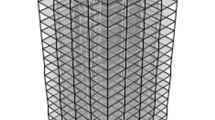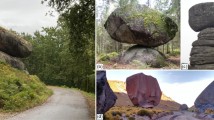Abstract
We analyze the effect of tectonic plate velocities in the earthquake pattern using a simple mass-spring model of the Burridge and Knopoff type with two blocks and a velocity-weakening friction law. Previous versions of the two-block model assume a steady driver during slip events (limit of zero driver velocity), which, in some cases makes necessary the introduction of artificial parameters to start the numerical integration of the equations of motion at impending slip of any block. Still maintaining the condition of zero driver velocity during slip, we shall introduce a procedure to start the numerical integration without introducing artificial parameters and this will be done by using a linearized version of the equations of motion valid for small velocities and considering nonzero driver velocity. We also introduce a four parameter model in which the driver velocity enters the equations during the whole simulation, and analyze the effect of the new parameter, the driver velocity, in the displacement and time patterns of blocks motion, directly related to earthquake statistics such as coseismic slips and average repeat times.
Similar content being viewed by others
References
Bak, P., andTang, C. (1989),Earthquakes as a Self-organized Critical Phenomenon, J. Geophys. Res.94, 15635–15637.
Brown, S. R., Scholz, C. H., andRundle, J. B. (1991),A Simplified Spring-block Model of Earthquakes, Geophys. Res. Lett.18, 215–218.
Burridge, R., andKnopoff, L. (1967),Model and Theoretical Seismicity, Bull. Seismol. Soc. Am.57, 341–371.
Cao, T., andAki, K. (1986),Seismicity Simulation with a Mass-spring Model and a Displacement Hardening-softening Friction Law, Pure and Appl. Geophys.122, 10–24.
Cao, T., andAki, K. (1986),Seismicity Simulation with a Rate and State-dependent Friction Law, Pure and Appl. Geophys.124, 487–513.
Carlson, J. M., andLanger, J. S. (1989),Properties of Earthquakes Generated by Fault Dynamics, Phys. Rev. Lett.62, 2632–2635.
Carlson, J. M., Langer, J. S., Shaw, B. E., andTang, C. (1991),Intrinsic Properties of a Burridge-Knopoff Model of an Earthquake Fault, Phys. Rev. A44, 884–897.
Chen, K., Bak, P., andObukhov, S. P. (1991),Self-organized Criticality in a Crack-propagation Model of Earthquakes, Phys. Rev A43, 625–630.
Cohen, S. C. (1977),Computer Simulation of Earthquakes, J. Geophys. Res82, 3781–3796.
Cohen, S. C. (1979),Numerical and Laboratory Simulation of Fault Motion and Earthquake Occurrence, Rev. Geophys. Space Phys.17, 61–72.
Dieterich, J. H. (1972),Time-dependent Friction as a Possible Mechanism for Aftershocks, J. Geophys. Res.77, 3771–3781.
Eckmann, J.-P., andRuelle, D. (1985),Ergodic Theory of Chaos and Strange Attractors, Rev. Mod. Phys.57, 617–656.
Gu, J. C., Rice, J. R., Ruina, A. L., andTse, S. T. (1984),Slip Motion and Stability of a Single Degree of Freedom Elastic System with Rate- and State-dependent Friction, J. Mech. Phys. Solids32, 167–196.
Horowitz, F., andRuina, A. (1989),Frictional Slip Patterns in a Spatially Homogeneous Elastic Model, J. Geophys. Res.94, 279–298.
Huang, J. (1990),Fractals and Chaotic Dynamics in Tectonics: Applications to Topography and Seismicity, Ph.D Thesis, Cornell University, 136 pp.
Huang, J., andTurcotte, D. L. (1990),Evidence for Chaotic Fault Interactions in the Seismicity of the San Andreas Fault and Nankai Trough, Nature348, 234–236.
Huang, J., andTurcotte, D. L., (1992),Chaotic Seismic Faulting with a Mass-spring Model and Velocity-weakening Friction, Pure and Appl. Geophys.138 (4), 569–589.
Huang, J., Narkounskaia, G., andTurcotte, D. L. (1992),A Cellular Automata, Slider-block Model for Earthquakes. 2. Demonstration of Self-organized Criticality for a Two-dimensional System, Geophys. J. Int.111, 259–269.
Ito, K., andMatsuzaki, M. (1990),Earthquakes as a Self-organized Critical Phenomena, J. Geophys. Res.95, 6853–6860.
Lomnitz-Adler, J., andPerez-Pascual, R. (1989),Exact Solvable Two-fault Model with Seismic Radiation, Geophys. J. Int.98, 131–141.
Lorenz, E. N. (1963),Deterministic Nonperiodic Flow, J. Atmos. Sci.20, 130–141.
Mikumo, T., andMiyatake, T. (1983),Numerical Modelling of Space and Time Variations of Seismic Activity before Major Earthquakes, Geophys J. R. Astr. Soc.74, 559–583.
Nakanishi, H. (1991),Statistical Properties of the Cellular-automaton Model for Earthquakes, Phys. Rev. A43, 6613–6621.
Narkounskaia, G., andTurcotte, D. L. (1992),A Cellular-automata, Slider-block Model for Earthquakes. 1. Demonstration of Chaotic Behavior for a Low-order System, Geophys. J. Int.111, 250–258.
Nussbaum, J. H. (1987),A Two Degree-of-freedom Earthquake Model with Static/Dynamic Friction, Unpubl. M.S. Thesis, Cornell Univ., 127 pp.
Nussbaum, J., andRuina, A. (1987),A Two Degree-of-freedom Earthquake Model with Static/Dynamic Friction, Pure and Appl. Geophys.125, 629–656.
Otsuka, M. (1972),A Simulation of Earthquake Occurrence, Phys. Earth Planet. Int.6, 311–315.
Rice, J. R., andTse, S. T. (1986),Dynamic Motion of a Single Degree-of-freedom System Following a Rate- and State-dependent Friction Law, J. Geophys. Res.91, 521–523.
Ruff, L. J. (1992),Asperity Distributions and Large Earthquake Occurrence in Subduction Zones, Tectonphys.211, 61–84.
Ruina, A. (1983),Slip Instability and State Variable Friction Laws, J. Geophys. Res.88, 10359–10370.
Stuart, W. D. (1979a),Strain Softening Prior to Two-dimensional Strike-slip Earthquakes, J. Geophys. Res.84, 1063–1070.
Stuart, W. D. (1979b),Aging and Strain Softening Model for Episodic Faulting, Tectonophys.52, 613–626.
Takayasu, H., andMatsuzaki, M. (1988),Dynamical Phase Transition in Threshold Elements, Phys. Lett. A131, 244–247.
Wolf, A., Swift, J. B., Swinney, H. L., andVastano, J. A. (1985),Determining Lyapunov Exponents from a Time Series, Physica D16, 285–317.
Author information
Authors and Affiliations
Rights and permissions
About this article
Cite this article
Brun, J.L., Gomez, J.B. A four-parameter, two degree-of-freedom block-spring model: Effect of the driver velocity. PAGEOPH 143, 633–653 (1994). https://doi.org/10.1007/BF00879502
Received:
Accepted:
Issue Date:
DOI: https://doi.org/10.1007/BF00879502




